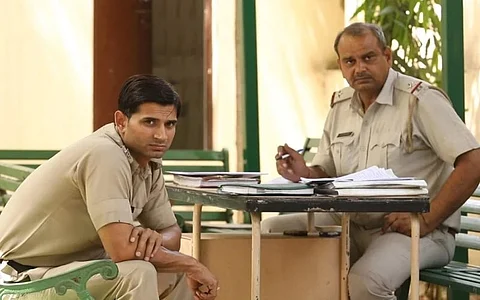
- Reviews
- Power List 2024
- Cannes 2024
- In-Depth Stories
- Web Stories
- News
- FC Lists
- Interviews
- Features
- FC SpecialsFC Specials

Creative directors: Mayurica Biswas, Pracheta Sharma
Genre: Documentary
Cinematographer: Gurvinder Singh
Editor: Anupama Chabukswar
Streaming on: Netflix
A Big Little Murder is a middling two-part documentary about India's most high-profile school killing in recent memory. The story itself is far more compelling than the storytelling. Given Netflix's sheer monopoly over the true-crime genre, I'm surprised this isn't a more refined work of nonfiction. However, I'm not surprised that its gaze – its moral core – is distinctly American: a South Asian version of the highschool-shooter syndrome. (Journalist Snigdha Poonam's urban eloquence while introducing Gurgaon as a "land of patriarchy, toxic masculinity and lawlessness" only bolsters this image). Without giving away too much, I'll just say that A Big Little Murder is as confused about its identity as, say, the Haryana police is about the identity of the killer. If this is deliberate, it's 'method' genius. But I'm fairly certain it's only a bad pun on my part.
The first segment does a decent job of world-building – until it doesn't. The young parents of 7-year-old Pradhyumn Thakur reminisce about his playful spirit. Then they start speaking about that fateful day: September 8, 2017. The title sequence is quite thoughtful: a pencil-sketched montage of a child's morning routine. The hymn-like score aims for that haunting destruction-of-innocence sound. Slowly but steadily, we learn of the events of the morning: Pradhyumn is dropped to the Ryan International School gate by his doting father, and within the hour, the parents are urgently summoned to a hospital because of an "accident" in the washroom. The boy is declared dead on arrival, and the narrative starts to zoom out for wider context – the site of the death, the blood stains, the hidden knife, the media coverage, the horrified faculty members, and most notably, the Gurgaon police 'investigation'. At this point, the documentary resembles the sinisterness of the film Talvar a lot – especially in the way the police botch up the case. Both the murders happen in NCR territories that, as a talking-head explains, developed so rapidly that they grew without a conscience.
The makers present the facts without really taking a side, which is nice and journalistic, but it's clear they're leaning towards the persuasive official version
Here's where A Big Little Murder starts to get dry and repetitive. The film-making is visibly rough around the edges. In trying to replicate the sensationalism of the media coverage, the documentary itself succumbs to this sensationalism. Some parts resemble a campy crime-patrol episode. The quasi-suspenseful music evokes the dissonance of a breaking-news telecast. The relentless aerial shots of the school – as though it were a hybrid of a doomed castle and an abandoned mall – flood the narrative interludes. I get that the intention is perhaps to highlight the stark anatomy of Gurgaon, where isolated concrete structures often look like they're impeding the sunbaked wilderness. The school looks chilling from this angle, but it feels like the makers are fetishizing the incident rather than exploring it. When a suspect is finally arrested, the film's access to the suspect's family members means that the second episode descends into a dramatization of technical jargon and CBI case details. Too long is spent mapping the geographical plausibility of the murder in the corridors. It's all well and good for a judge in a courtroom to see numbers and measurements on a screen – but this doesn't exactly make for the most immersive hook in an investigative documentary.
The makers present the facts without really taking a side, which is nice and journalistic, but it's clear they're leaning towards the persuasive official version. This is evident in how – before we know it – the episode abruptly morphs into a somber portrait of cultural psychoanalysis. This is not unusual or wrong (there is no wrong in nonfiction), but it's certainly not the most organic course of action. The sudden pull-out – where the troubling past of the suspect is revealed through interviews with friends and the prism of hindsight – doesn't fully commit to the broader perspective. The focus is not on the victim anymore, because as per the makers, perhaps the perpetrator is a bigger victim. A psychiatrist and an ex-founder lament about a 'system' that misses the signs, and that's that. It doesn't help that some identities are concealed for legal reasons, which further hampers the raw personality of the film.
I couldn't help but think of the best-case scenario for such a documentary. Michael Moore's Oscar-winning Bowling for Columbine is seared into the memory of those who recognize the relationship between a physical tragedy and the cultural failings of a nation. A Big Little Murder is at best a pimple-faced, adolescent cousin of Moore's masterpiece. There's a long way to go, but India has a prickly equation with the pursuit of truth. The information withheld – by cops, politicians, lawyers and the administration – reveals far more than the information offered. I'm not sure this aids an investigational outlook. Or any outlook at all.